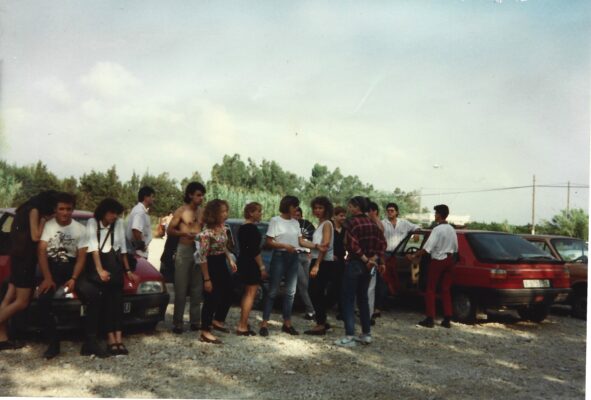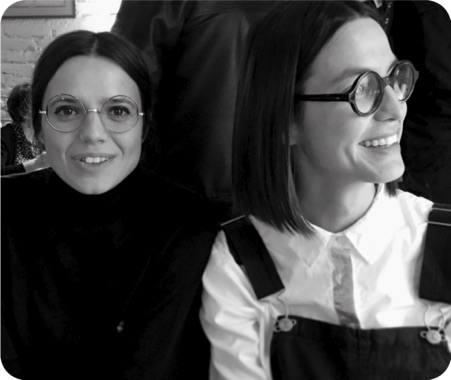Search
To search for an exact match, type the word or phrase you want in quotation marks.
A*DESK has been offering since 2002 contents about criticism and contemporary art. A*DESK has become consolidated thanks to all those who have believed in the project, all those who have followed us, debating, participating and collaborating. Many people have collaborated with A*DESK, and continue to do so. Their efforts, knowledge and belief in the project are what make it grow internationally. At A*DESK we have also generated work for over one hundred professionals in culture, from small collaborations with reviews and classes, to more prolonged and intense collaborations.
At A*DESK we believe in the need for free and universal access to culture and knowledge. We want to carry on being independent, remaining open to more ideas and opinions. If you believe in A*DESK, we need your backing to be able to continue. You can now participate in the project by supporting it. You can choose how much you want to contribute to the project.
You can decide how much you want to bring to the project.

I was about thirteen years old when I got my first invitation. And wham! It was from the brother of a friend who had just been in Metro and in Central. That was real far away from us and our eyes just bugged out. The first four invitations I kept on the desk in my room with Scotch tape on the back. I would study there in that corner of the room with those four invitations and hundreds of cassette tapes that I recorded from the radio as decoration. Unable to go out and party, I stayed up listening to Bikini Club, a famous radio program of the 1990s. You were in your room, climbing the walls, listening to all that music without being able to go out[1]Vista Oral; Hernández Rubén (2022) La ruta del bakalao. Museo del remember (1985-2012). Colpa Press..
This is how Ruben Hernández’s book about la Ruta del Bakalao begins. His tendency to accumulate, a force of pure imagination that is still going more than thirty years later and which created the Museo del Remember located in the garage of his house, in Jacarilla, Alicante. A space covered with merchandising, posters, invitations, LPs, cassettes and CDs in different display cases made with reused materials, abundant desire and imagination, and whose premise was its coexistence with a functioning garage.

View of Museum of Remember. Photo: Rubén Hernández
The vast majority of collectors never stop collecting. There are always objects that they don’t own and that could become key pieces for their collections, or ones that are an excuse to start a new one. Collecting is a form of knowledge capable of mobilizing and acting on instant associations. No collection, however individual it might be, can be completed in absolute solitude. It is trading, and not the economic transactions based on market value, that allows the continuous process of collecting. The value of objects, which is always an agreement between communities, undergoes a peculiarity in the case of collectors. There is a mutual understanding of an object’s value to others, and trading occurs within systems of communication that respond to an internal logic of this function. Collections, like communities, are always utopian and imperfect, exploring the existing balance between the combination of personal time and collective experience, sustained by a sense of belonging.
We’re united by our excessive movement, by our estrangement from ourselves, and it was in this estrangement, in the excess of our individual experiences, that our community, at least for a short time, existed[2]Colquhoun, Matt. Egreso (2021). Caja Negra Editora..
The objects in Rubén’s collection, the music of the time, the way the fans dressed, the scenography of the dance floors, the buildings that housed them and gave them shape (and which are now mostly ruins), help construct the imagery of la Ruta. La Ruta is a cultural movement with almost no theoretical description or intellectual consensus, full of omissions, with parallel and even contradictory histories, collective and dissident, far from any official narrative. However, la Ruta was something more than the irrelevant and banal act portrayed by the media of the time, an image which people timidly shrink away from today. The bakalao or bacalao was a collective experience, an act of escapism that allowed its protagonists to overcome social barriers and within which our most recent history and the necessary revision of the celebratory attitude of the Transition exist. It was a kind of social mirage in which it seemed that all the rules created during the Franco regime disappeared with the drafting of the Constitution, despite the fact that many of the biopolitical constructs of the Dictatorship were still present in the 1980s (and today, as well), such as the regulation of the domestic sphere. These social norms were challenged through a kind of extreme nightlife, a clear example of an endgame without an end, of alternative, shared spaces, of a breaking with conventions, bummers and bad trips notwithstanding.

Arsenal Parking 1989. Susana Oliva Archive
More than a moment of freedom, we lived a moment of anomie, anomie being the absence of laws. Powers had been transferred, the communities had not yet passed laws, there were no nightlife ordinances, there were no restrictions for business hours, there was nothing. I think this is the most interesting part of the story[3]Vicente Pizcueta en Bacalao. Historia oral de la música de baile en Valencia, 1980-1995. Costa, L. (2016) Contra.
Illegal raves in industrial warehouses and open fields, generated by a utopian pirate spirit and popular in other European countries at the end of the 1980s and beginning of the 90s, were not necessary in Valencia, where the movement took advantage of legal loopholes to develop its strategies of proletarian escapism with its own ritual aspects. The lack of regulation of the business hours of clubs and the entrepreneurial vision of nightlife favored the creation of a sophisticated system of raw spaces where thousands of young people could dance, moving back and forth between one club and another in cars during endless weekends. Cars were the only possible means of transportation between these “networked islands[4]Concept of “island networks” in “temporary autonomous zones” from the anarchist theorist Hakim Bey, which Simon Reynolds applied to rave culture in his book Energy Flash. Un viaje a través … Continue reading,” and the parking lots full of cars in front became extensions of the clubs. People invested in huge speakers for their small cars (Ford Fiesta, Renault 5, Golf GTI), and mechanics in the area specialized in custom tune-ups. Trunks were filled with bottles of liquor and the normally inert space of parking lots became a party in which dance and music were the center.

Leaving Chocolate parking to go to Spook. February 1988. Susana Oliva Archive
The music in this scene was the trigger for a Dionysian spirit of communing in a complete, carnal way. Musician gave way to producers and engineers, the song or track was more important than the album, and mixtapes become popular. El bacalao was not for Walkmans, it wasn’t music for individual listening pleasure or private spaces. The live session cassettes being passed around were played at full volume in cars with windows down and trunks open. In this context, music went from being a one-way narrative to a collective construction that was completed on a dance floor and experienced through a sound system. Previous forms of musical encounters were abandoned, and with them the distances between those who produced and those who listened to music. The dance floor became a space for collective sensory immersion and communion, but it was also a political space of resistance with an unprecedented democratization of leisure. It’s no coincidence that the peculiar assimilation and subsequent emergence of Detroit techno produced in Berlin took place after the fall of the wall separating the two Germanys, nor that the appearance of la Ruta took place in Spain during the Transition after the death of the dictator and the end of the Franco regime. The collective need for freedom in a society subjected to decades of repression occurred in both cases with unusual freshness and virulence, a mix between escapism and a flight into an unknown outer space.
Drugs aided the disinhibition and mystical trance marked by the characteristic sound of the bass of postpunk and bakalao. Riffs rocked to the rhythm of drugs, and first mescaline and then ecstasy[5]“To be in ecstasy means, literally, going outside, dislocating, externalizing, modifying a thing or a state of things. It also means going away, distancing, abandoning, leaving, giving up, … Continue reading got people “high.” A probably unconscious dissident power could be seen in young people dancing until they dropped in alternative spaces, in their camaraderie, hedonism and excess, and in their particular cosmic trip to try to escape from Earth[6]“Maldición, ya es domingo y esto cierra, todo el mundo a la nave, nos volvemos a la Tierra” (Damn, it’s Sunday and the club’s closing, everyone in the ship, we’re going back to Earth). … Continue reading, united by collective euphoria, rebels without theory against the established system.
For some (…) the idea of rave culture is a contradiction of terms. Culture can be defined as something that tells you where you come from and where you are going, something that feeds the spirit, conveys life wisdom, and generally makes life livable. Rave begs the question: can a culture be based on sensations instead of truths, on fascination instead of meaning?[7]Reynolds, Simon. Energy Flash. Un viaje a través de la música rave y la cultura de baile (2014). Contra.
(*) Tomates Eléctricos (1981, reedited in 2009), La orgía de los Selenitas included in the album Teléfono Rojo. Synth pop
(Cover photo: Parking Arsenal 1989. Susana Oliva Archive)
| ↑1 | Vista Oral; Hernández Rubén (2022) La ruta del bakalao. Museo del remember (1985-2012). Colpa Press. |
|---|---|
| ↑2 | Colquhoun, Matt. Egreso (2021). Caja Negra Editora. |
| ↑3 | Vicente Pizcueta en Bacalao. Historia oral de la música de baile en Valencia, 1980-1995. Costa, L. (2016) Contra |
| ↑4 | Concept of “island networks” in “temporary autonomous zones” from the anarchist theorist Hakim Bey, which Simon Reynolds applied to rave culture in his book Energy Flash. Un viaje a través de la música rave y la cultura de baile (Energy Flash: A Trip through Rave Music and Dance Culture) (2014) Contra. |
| ↑5 | “To be in ecstasy means, literally, going outside, dislocating, externalizing, modifying a thing or a state of things. It also means going away, distancing, abandoning, leaving, giving up, renouncing, separating. The word ecstasy indicates displacement, change, deviation, alienation, disturbance, delirium, stupor, excitement.” Perlongher, Néstor (2004) Antropología del éxtasis (Anthropology of Ecstasy). Urania. |
| ↑6 | “Maldición, ya es domingo y esto cierra, todo el mundo a la nave, nos volvemos a la Tierra” (Damn, it’s Sunday and the club’s closing, everyone in the ship, we’re going back to Earth). Lyrics from Viva la fiesta, Paco Pil, 1993. |
| ↑7 | Reynolds, Simon. Energy Flash. Un viaje a través de la música rave y la cultura de baile (2014). Contra. |

Vista Oral are Alicia Escobio and Maite Muñoz, a collective of curators and researchers. We are interested in failure, uselessness and any political dimension of unproductivity. We approach projects as an apprenticeship in which, together with an artist, we open participatory spaces based on interaction and exchange of tools and micro-narratives that help us to generate a collective critical discourse. In Los Angeles we managed Garaje, and previously we were in charge of the space 56x45x25. Together with Eloi Gimeno, we co-directed the publishing house Folleto until 2019. We are currently part of the international collective continent.
"A desk is a dangerous place from which to watch the world" (John Le Carré)